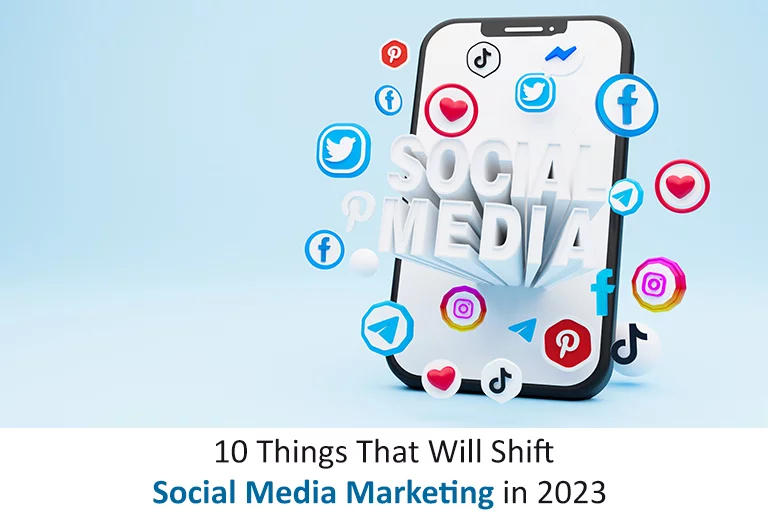After more than a decade of growing pains, Social Media Marketing has finally developed as a career. In 2023, successful social marketers will carefully examine their possibilities, use a scalpel rather than a cleaver, and consider the long-term consequences of their short-term activities.
What is meant by Social Media Marketing?
SMM or Social Media Marketing is a type of internet marketing that uses social media apps as a marketing strategy. These social media platforms allow companies to engage with their target audience to: create a brand, improve sales, generate traffic to a website, and so on. It uses social media channels to establish a company’s brand, increase sales, and generate website traffic. It interacts with customers using social media channels to create brands, improve sales, and generate website traffic.
SMM is all about engaging with your target audience or consumers and assisting them in better understanding your company. It is advantageous to the success of your firm. Assume you’re about to meet someone for the first time to develop a positive connection. What should you do to make that individual like you immediately because you won’t have another chance? Will you succeed if you meet that individual and say dull or useless things?
People admire you the most when you keep them satisfied, no matter how you do it.
Why choose Social Media Marketing in 2023?
By communicating with customers on social media, marketers may discover what inspires them. Brand recognition, client loyalty, better conversions, and cost-effectiveness are all compelling reasons to prioritize Social Media Marketing for your business. The foundation of suitable Social Media Marketing in 2023 is speaking to a specific audience through your social postings. You’ll also need to construct audience personas if you still need to get a good sense of your target audience.
10 Things that will shift Social Media Marketing in 2023
The Social Media Marketing research is based on interviews with network agencies. All of the responses were condensed into 10 significant predictions for 2023:
- Search is becoming more social
Google has discovered that nearly half of the young people seek solutions on social sites like Instagram rather than Googling. The younger generation’s purchasing journey begins with curiosity. It is up to companies and marketers to lead them along a road of inspiration and ideas rather than brands and things.
- Creator Culture is flourishing
A content developer is someone who creates and distributes digital content. While anybody with an Instagram account is creative, professional content producers go a step further. They leverage their digital channels to grow a following and monetize their material. The producers create content for self-branding, creative autonomy, professional growth, and community building.
- The reintroduction of social media
Gen Z believes that material should be realistic and “genuine” and that it should remind individuals online that they are not alone. Authentic content does not sell or preach; it is the video or static post that a buddy would produce and send you to make you laugh or weep, according to the Adolescent Content/Youth tellers team.
- Using social media to humanize B2B transactions
When communicating with customers, humanizing your brand implies using a more approachable and friendly communication style rather than traditional corporate lingo. Consider it as creating your brand’s identity and values via genuine relationships with your target audience. Humanizing a B2B Brand necessitates a change from product to the audience. It entails admitting that purchase choices are influenced by emotion and marketing to the issues that decision-makers encounter rather than your company’s offers.
- Niche influencers will break into the mainstream
Next year, influencer marketing might focus on relatable, more approachable artists. Trust is placed in specialized community pioneers, micro-influencers, and thought leaders.
- The Metaverse will expand through social media
The Metaverse will combine social media marketing in 2023, such as collaboration, commerce, live events, and immersive experiences based on virtual and augmented reality (AR). Proponents claim that the virtual worlds of the Metaverse will promote teleworker camaraderie. Improve cooperation, speed up training, minimize the need for office space, and make work happier. The current Metaverse trends include VR and AR games, virtual galleries, art exhibitions, real estate, social networking areas, and so on.
- Increasing the popularity of short-form video
They are frequently more shareable than long-form video, which means they can reach a larger audience. Finally, short-form videos are more interesting than longer-form videos, making them more successful at conveying information or pushing a message. The most effective social media marketing in 2023 is short-form video content. Short-form videos are quick-hitting, compelling content that helps your audience notice and connect with your business or service without devoting too much time.
- B2B influencer marketing is booming
Influencer marketing has transcended beyond trends and has become a purposeful technique. It is expected to grow further in B2B. Thus businesses must be proactive in incorporating influencer marketing into their entire strategy. Influencer marketing helps B2B companies accomplish goals ranging from improving brand recognition and reputation to directly increasing revenues. A third of companies say influencer marketing has improved revenue, and 85% think interest in working with influencers will grow in the coming year.
- Updating the engagement metrics
Conversations are in, and likes are out. New social media channels and methods have transformed users, which should change how businesses assess themselves.
- Predictive analytics to help goal-setting
Instead of asking what happened, we will ask what is likely to happen. And for that, we will require data. There is a lot of info. Predictive analytics is valuable and practical in virtually every business, from finance to aerospace. Forecasting inventories, managing resources, determining ticket pricing, monitoring equipment maintenance, generating credit risk models, and many more applications rely on predictive models.

